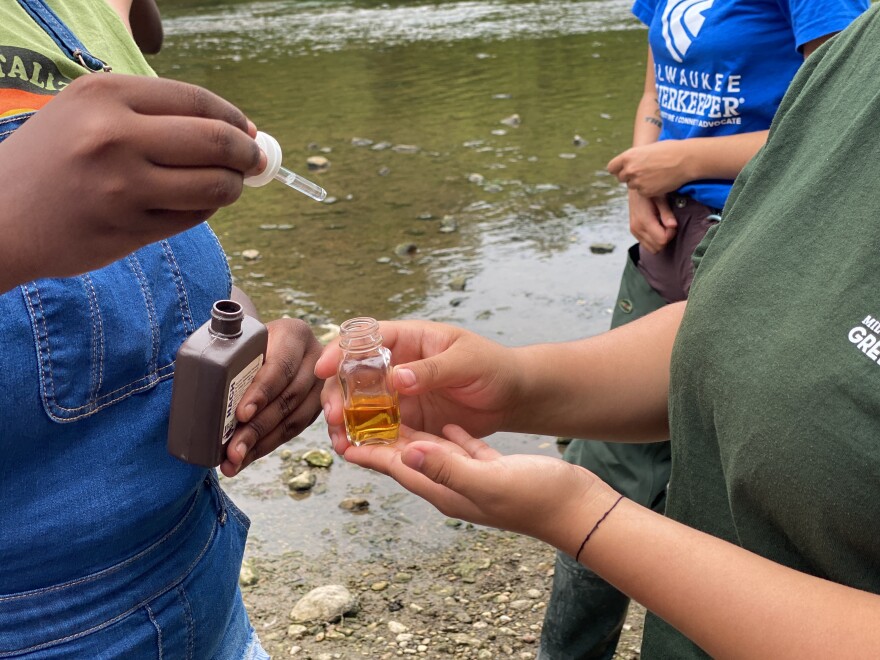A new report card outlines the health of the Milwaukee River basin. It's an annual product of the Milwaukee Riverkeeper.
The grade isn’t great, but it’s better than the year before. The basin moved from a score of D+ to C-.
The basin is big, and a barrage of stressors challenge its health.
Spanning 900 square miles and seven counties, the basin includes the Kinnickinnic, Milwaukee and Menomonee Rivers and their tributaries.
Dozens of volunteers spread through the watersheds, plunking gauges in its waters from May through October.
Jane Kolberg showed WUWM's Susan Bence where her monitoring gig began back in 2009. “We’re on the Menomonee River in Hart Park near the senior center,” Kolberg said.
As Kolberg gradually learned more, she was joined by her sister, Jill Schaeffer.

“So Jill and I started monitoring for the basics. Then we reached level 2, that means we learned more and used more complicated equipment,” Kolberg explained.
Even a couple of tumbles into the river didn't stop Kolberg and Schaeffer.
Today they’re a trio, with the addition of Jill’s husband Don Schaeffer. Together they monitor six sites throughout the basin.
"The sites do not take us long. We're at each site 20 minutes maybe. It's the drive time. If you're going to go up to Campbellsport, you might as well do a bunch," Don Schaeffer said.

“We couldn’t do this without our volunteers,” said Cheryl Nenn of the Milwaukee Riverkeeper.
The Milwaukee Riverkeeper is a small organization that coordinates monitoring, crunches the data, and presents the annual report card.
Nenn said it folds in not only what's living in the watershed but averages variables, from water temperature to turbidity.
“Turbidity is the cloudiness of the water caused by suspended particulates in the water which is lot of dirt and sediment,” Nenn explained.
Too much turbidity stresses or could even kill aquatic organisms critical to the food chain.
“Turbidity can be stressful for fish,” Nenn added. “It gets into their gills and for fish that lay their eggs on the bottom of the river, the sediment can smother those eggs.”
Nenn said turbidity is a byproduct of runoff after storms.
“And especially a watershed like the Menomonee that is about 80% urban. It’s very flashy,” Nenn said.
That means after a heavy rain, runoff enters the river really quickly.
“The water level rises fast and tends to lower really fast, so the stream itself becomes a source of sediment,” Nenn said.
Another stressor that factors into the report card is road salt applied in the winter that makes its way into rivers and streams.
“We have two creeks. One that comes in right here around the corner, Honey Creek, and Underwood Creek. That comes in about a mile upstream of where we’re standing," Nenn said. "They both drain from I-94, and they are very heavily impacted by road salt."
Kolberg, with tearful eyes, remembers her first winter monitoring experience.
"I did the confluence where Honey Creek comes in and joins this, and it was a fish kill. I did it the next day. It was a fish kill, the levels were so high, and I had to report a fish kill on that wonderful little creek. But then we went back to monitor the next year, and there were little fish that had come upstream, and we were so excited. So they can still find a way," Kolberg said.
Nenn suggests the upswing is primarily due to the fact that there was less rain during the last reporting cycle than the previous one cycle.
“Generally more rain means more runoff, which means more pollution,” Nenn said.
Nenn said the report and the monitoring has a greater purpose.

“We want to be a science-based organization, so that our advocacy is science-based,” Nenn said.
She says the work also serves as an educational tool, “to show people what we do impacts waterways. What we do can make a difference.”
Nenn remains focused on the ultimate goal set by the Clean Water Act.
“I think people should be able to feel they can safely swim in the rivers, that they can go into the Menomonee River and catch a fish and take it home and eat it and not worry whether it has oil or contamination in it,” Nenn said.
Don Schaeffer thinks it’s important to take a long view.
"I'm a senior citizen, and when I was a youth, the river was foaming from phosphate detergent, and we were told it was too expensive to get rid of it. [Then] it happened," he said.
Don Schaeffer said water quality has improved in his lifetime. He expects it’ll keep improving.
Have an environmental question you'd like WUWM's Susan Bence to investigate? Submit below. (If the module isn't appearing, please refresh the page.)
_







